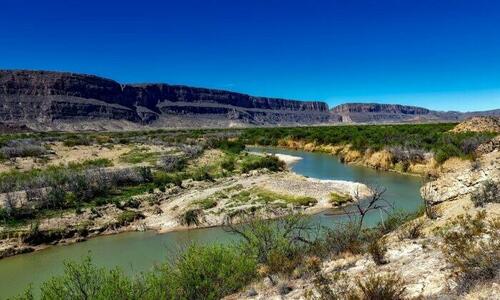Authored by Suzanne Gasparatto via The Epoch Times,
Humans cannot live without water, yet many of us take for granted that water is readily available. As more people move to cities, adding to already crowded populations, the availability of potable water isn’t a given any longer.
While this planet has plenty of water, its distribution does not always coincide with areas where lots of people choose to live.
For decades, Texans, like citizens of other states, have been struggling with regional water issues. Heavily populated but still growing Central Texas has long been known as an area of perpetual drought occasionally interrupted by flash floods. The booming metropolis of Austin, Texas, literally sits on top of water problems. Underneath Austin is the Edwards Aquifer, which experiences rapid changes in water levels due to high demand. Other Texas cities have similar problems.
Cities as small as San Angelo and as large as San Antonio have purchased water rights in rural areas, diverting the supply of water used by farmers and ranchers over long distances for urban use. Rural Texas, which already had serious water deficits, is in trouble. Farmers and ranchers must have reliable supplies of water to produce the food that we eat.
The Highland Lakes northwest of Austin were originally built to control downstream flooding and deliver water to farmers and ranchers. The population shift from rural to urban has placed huge demands on this water supply. Lack of rain plus additional urban population has caused water levels in lakes to be so low that boat docks are far from the shoreline.
The recent large influx of people to Texas has spurred groups of investors to buy rural land and develop it into subdivisions. These investors are often from other states and are unaware of our water woes. They don’t realize that most rural Texas properties, including my location north of fast-growing Austin, depend upon individual water wells drilled by each property owner. Municipal water systems are nonexistent. Drilling deeper wells is not an option. Good-quality water isn’t available below relatively shallow levels.
Existing wells are drying up as demand for more wells arises with the building of new subdivisions. Many people, including those in existing subdivisions, are having to purchase water in bulk and have it delivered to meet their basic needs.
County officials in Texas do not have sufficient authority to manage growth while protecting our water resources. This authority needs to come from the Texas Legislature soon. Requiring larger acreage to qualify to drill a well is critical. Today, permission to drill a well can be obtained if you own as little as two acres.
Adjacent to my ranch, developers are selling four-acre to six-acre tracts that will result in 205 additional water wells. Folks who spend $250,000 to $350,000 for these tracts will expect that there is plentiful water to fill their swimming pools and water their landscaped lawns. This isn’t accurate.
These new wells will decimate our agricultural wells that are already low from years of drought. My County Commissioners Court doesn’t have authority to control this growth in a reasonable and fair manner for all residents.
A short-term solution involves increasing the acreage required to drill a well from two acres to at least ten acres and requiring rainwater collection systems in conjunction with all new wells. When I bought this land, a professional engineer designed a rainwater collection system off the metal roof of my barns, from which I water all my livestock. That allowed me to reserve well water for personal use only, and I monitor usage daily.
Requiring new wells to have pumps that limit pumping gallonage is necessary.
The regional underground water conservation district recently added some new regulations, which, for new wells on small acreage, will limit pumping output.
This is only a start in trying to manage over-consumption of available groundwater.
A medium-term solution is to build desalination plants to clean up the brackish water that exists below current potable water well levels.
A longer-term solution is building desalination plants along the Gulf Coast and creating a network of water pipelines throughout Texas to transport desalinated water to areas needing it. Existing easements for oil and gas pipelines can be made accessible for these water pipelines.
U.S. taxpayers contributed vastly to the development of desalination plants around the world. It is time to take care of our own citizens’ water needs.
In many populated areas, we have a shortage of adequate distribution of water. Vast parts of the western United States, on the other hand, have little water at all, and what they have is often being bought by cities and piped away from the source. Solutions are available. We only have to have the will to implement them.
Tyler Durden
Mon, 04/15/2024 – 23:00

